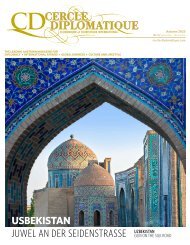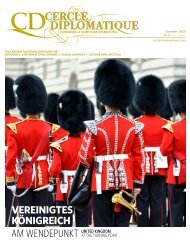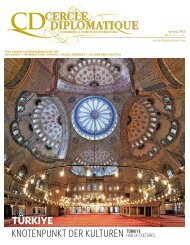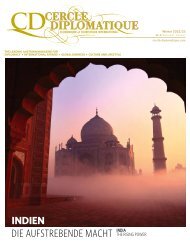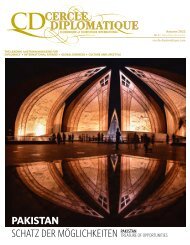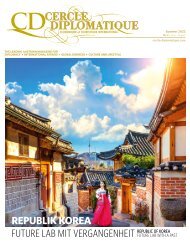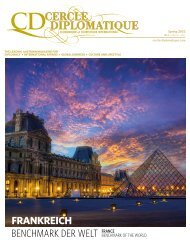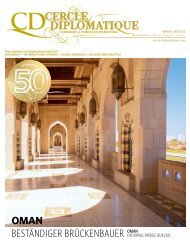CERCLE DIPLOMATIQUE - issue 04/2019
CD is an independent and impartial magazine and is the medium of communication between foreign representatives of international and UN-organisations based in Vienna and the Austrian political classes, business, culture and tourism. CD features up-to-date information about and for the diplomatic corps, international organisations, society, politics, business, tourism, fashion and culture. Furthermore CD introduces the new ambassadors in Austria and informs about designations, awards and top-events. Interviews with leading personalities, country reports from all over the world and the presentation of Austria as a host country complement the wide range oft he magazine.
CD is an independent and impartial magazine and is the medium of communication between foreign representatives of international and UN-organisations based in Vienna and the Austrian political classes, business, culture and tourism. CD features up-to-date information about and for the diplomatic corps, international organisations, society, politics, business, tourism, fashion and culture. Furthermore CD introduces the new ambassadors in Austria and informs about designations, awards and top-events. Interviews with leading personalities, country reports from all over the world and the presentation of Austria as a host country complement the wide range oft he magazine.
- No tags were found...
You also want an ePaper? Increase the reach of your titles
YUMPU automatically turns print PDFs into web optimized ePapers that Google loves.
LE MONDE MONGOLIA
From tradition to modernity
FACTS &
FIGURES
Mongolia has mastered the transition to a prospering country. Sustainable
tourism in a land full of beauty will be the power of the future.
Text: Daniela Pötzl
PHOTOS: ADOBESTOCK, EMBASSY OF MONGOLIA, B. BAYAR
Mongolia, the East Asian country geographically
located between the Russian Federation
and the People’s Republic of China, is in
possession of a vast and interesting history. The area
of what is now Mongolia has been ruled by various
nomadic empires, including the Xiongnu, the Xianbei,
the Rouran, the Turkic Khaganate, and others. In
1206, Genghis Khan founded the Mongol Empire,
which became the largest contiguous land empire in
history. His grandson Kublai Khan conquered China
to establish the Yuan dynasty. After the collapse of the
Yuan, the Mongols retreated to Mongolia. In the 16th
century, Tibetan Buddhism began to spread in Mongolia,
being further led by the Manchu-founded Qing
dynasty, which absorbed the country in the 17th century.
By the early 1900s, almost one-third of the adult
male population were Buddhist monks. After the collapse
of the Qing dynasty in 1911, Mongolia declared
independence, and achieved actual independence
from the Republic of China in 1921. Shortly thereafter,
the country came under the control of the Soviet
Union, which had aided its independence from China.
In 1924, the Mongolian People‘s Republic was
founded as a socialist state. After the anti-Communist
revolutions of 1989, Mongolia conducted its own
peaceful democratic revolution in early 1990. This led
to a multi-party system, a new constitution of 1992,
and the transition to a market economy.
Mongolia is also a member of the United Nations,
Asia Cooperation Dialogue, G77, Asian Infrastructure
Investment Bank, Non-Aligned Movement and
NATO global partner.
Mongolia and Austria have been keeping cordial
relations for decades. In 1963, Austria was one of the
first countries in Western Europe to establish diplomatic
relations with Mongolia. In 2018, the 55th anniversary
of the establishment of diplomatic relations
between the two countries was celebrated. ”Our
relations continue to evolve, driven by political mutual
trust and economic cooperation”, states the Ambassador
of Mongolia to Austria, H.E. Battungalag
Gankhuurai in the interview with CD, see page 46.
And Mongolia’s involvement in the Asia-Europe
Meeting (ASEM) goes back to an Austrian initiative
during the EU Presidency in the first half of 2006.
ASEM has been serving as an exclusive venue for
Asian and European partners to deliberate on their
common challenges and opportunities for more than
20 years.
The Austrian Presidency of the Council of the European
Union in 2006 coincided with the 10th Anniversary
of the Asia-Europe Meeting (ASEM). At the
beginning of its Presidency, Austria recognized the
importance of the partnership between Asia and Europe
and stressed the important role of the ASEM
process as a platform for dialogue and cooperation
between two continents.
The Helsinki Declaration on the Future of ASEM
was adopted by the Heads of State and Government
at the 6th ASEM Summit in 2006. The Declaration
reaffirmed ASEM’s role as a catalyst in the broader
context of EU-Asia relations. In this context, 5 countries,
including Mongolia were endorsed at the summit
level to join the ASEM. That was another historic
testimony of close relations of the two countries.
In 2016, Mongolia was hosting the ASEM Summit
in Ulaanbaatar. That time, ASEM celebrated its
20th anniversary and offered the opportunity to
drive the partnership between Asia and Europe forward
through increased connectivity. ”The Ulaanbaatar
Declaration, adopted at the 11th ASEM Summit,
provided the forum with a roadmap setting out
ASEM’s priorities as it enters its third decade with a
view to building an inclusive, sustainable and radiant
future for our people and to ensuring a peaceful life
and shared prosperity for present and succeeding generations”,
explains Ambassador Gankhuurai.
In 1992, the first democratically elected parliament
of Mongolia, the State Great Khural, adopted a
new constitution, confirming the nation’s aspiration
to become a democratic and prosperous country.
Mongolia is a country with a high record of GDP
growth of 17.5% in 2011 and a stable economic
growth now. In 2018, our economy grew 6.9%, exceeding
expectations.
Mongolia
Population: 3,256,176 (2019 estimate)
Capital: Ulaanbaatar
Official language: Mongolian
Area:
1,566,000 km 2
Religion:
• Buddhism: 53%
• Non-religious: 38.6%
• Islams: 3%
• Shamanism: 2.9%
• Christianity: 2.2%
• Others: 0.4%
Form of government:
Unitary semi-presidential republic
President: Khaltmaagiin Battulga
Prime Minister: Ukhnaagiin
Khürelsükh
Currency: Tögrög (MNT)
GDP (PPP) per capita: 14,270 USD
(2019 estimate)
The State Great Khural (top) is
Mongolia‘s Paliament.
The country‘s neighbours are the
Russian Federation and the People‘s
Republic of China (below).
ULAANBAATAR is the
largest city of Mongolia
where almost half of the
country‘s whole population
lives.
The Zaisan Memorial in the
south of Ulaanbaatar honours
allied Mongolian and Soviet
soldiers killed in World War II.
(above);
Mongolian horsemanship at its
best (right).
42 Cercle Diplomatique 4/2019
Cercle Diplomatique 4/2019
43





